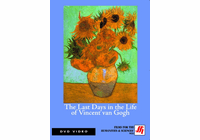The Eternal Sadness of Van Gogh
The Eternal Sadness of Van Gogh
by K.W.West
One of the most celebrated and easily recognizable artists of modern times, Vincent van Gogh lived a life of penniless ignominy and died an undignified death at his own hand. A prototype for the image of the troubled artist, Van Gogh suffered from bouts of dementia and waged a lifelong battle against severe depression. His heroic attempts to try and achieve artistic clarity, despite his illness and lack of rewards or recognition, are an inspiration to all who attempt an artistic endeavor.
Much of Van Gogh’s early work was destroyed by the artist. Frustrated at his perceived failures, the self-taught artist raged against his lack of technical skill and burned or re-used many of his early attempts. Art historians estimate that Van Gogh re-used a third of his overall output and advanced x-ray techniques have uncovered drawings and previous paintings underneath finished paintings. The University of Antwerp recently uncovered a woman’s face painted underneath one of Van Gogh’s exhibited paintings.
An aspiring pastor who wished to preach the gospel, Van Gogh’s earliest sketches were of the people he encountered while on a religious mission to a mining town in Belgium. His first major oil painting depicted a family eating potatoes by the light of an oil lamp. “The Potato Eaters” is a somber, earthy portrait, Van Gogh spoke of this work as his most accomplished portrayal and in letters to his sister spoke of his pride in capturing the essence of people “who eat with the same hands that work the land.” This work was one of the first to be exhibited, although his paintings at this time were dismissed as too dark and coarse by the critics and snubbed by the public.
Van Gogh’s artistic life took a major turn in 1886 when he moved to Paris with his art-dealer brother Theo and began to apprentice at the studio of Fernand Cormon, a prominent painter of historical subjects. Paris at this time was abuzz with the emergence of a new style of painting called Impressionism. The name was taken from a work by Claude Monet, “Impression, Sunrise” which was given a satiric review by art critic Louis Leroy. The artistic community appropriated this mocking term and used it to describe themselves. Van Gogh began to assimilate the techniques of impressionism into his work, especially the concept of “pointillism”. This technique, whereby a picture is created through a pattern of small dots of pure color, was popularized by George Seurat. Van Gogh also began a famous friendship with artist Paul Gauguin at this time, a relationship which initially blossomed through a shared love of woodcuts and Japanese prints.
Van Gogh moved to the south of France in 1888, seeking some respite from the art world of Paris. He had produced over 200 paintings during his two years in Paris, however he was ill from his heavy smoking and daily imbibing of absinthe. He settled into the village of Arles, a place where he found the light to be exceptionally “vibrant” and set to producing some of his most vivid and memorable landscapes and still life portraits. Joined in Arles by Gauguin, the initial partnership of the painters produced some exceptional collaboration, however tensions between the two resulted in the famous confrontation with a razor blade that ended with Van Gogh slicing off his own ear lobe. Run out of town by the villagers, who referred to him as “fou roux” the “mad redhead”, Van Gogh was admitted to an asylum in St. Remy for psychiatric care.
Now limited to short supervised walks in the countryside, Van Gogh turned to the work of other artists for inspiration. His interpretation of the works of realists like Jules Breton and Gustav Dore resulted in some of his most compelling creations as well as some of the most disturbing insights into his troubled soul. His painting “The Round of the Prisoners” was based on a Dore engraving and features a group of shuffling figures before a backdrop of imposing institutional walls. The prisoner facing the viewer bears the likeness of Van Gogh and wears a chilling expression of resignation. The most famous of Van Gogh’s paintings, “The Starry Night”, was a reproduction of the view from his asylum window and the swirling composition of the night sky has been much analyzed for evidence of his madness and proclaimed as proof of his genius.
The final works of Van Gogh are particularly bleak. “At Eternity’s Gate” depicts an aged man seated with his head held in his hands, experiencing extreme sorrow and regret at the moment of his passing. For an artist who was at the peak of his powers, yet often deprived by illness of being able to create, this was likely to be a familiar theme of a life unfulfilled. Perhaps most prophetic of his final paintings was “Wheatfield with Crows” a depiction of golden fields under a dark and troubled sky, with a flock of crows taking flight as if they had been recently startled. A few days after completing the painting he walked into the field with his easel, paints and a revolver. Three days later he succumbed to the self-inflicted wound in his brother’s arms. His last words were reported to be “this sadness will last forever.”
by K.W.West
One of the most celebrated and easily recognizable artists of modern times, Vincent van Gogh lived a life of penniless ignominy and died an undignified death at his own hand. A prototype for the image of the troubled artist, Van Gogh suffered from bouts of dementia and waged a lifelong battle against severe depression. His heroic attempts to try and achieve artistic clarity, despite his illness and lack of rewards or recognition, are an inspiration to all who attempt an artistic endeavor.
Much of Van Gogh’s early work was destroyed by the artist. Frustrated at his perceived failures, the self-taught artist raged against his lack of technical skill and burned or re-used many of his early attempts. Art historians estimate that Van Gogh re-used a third of his overall output and advanced x-ray techniques have uncovered drawings and previous paintings underneath finished paintings. The University of Antwerp recently uncovered a woman’s face painted underneath one of Van Gogh’s exhibited paintings.
An aspiring pastor who wished to preach the gospel, Van Gogh’s earliest sketches were of the people he encountered while on a religious mission to a mining town in Belgium. His first major oil painting depicted a family eating potatoes by the light of an oil lamp. “The Potato Eaters” is a somber, earthy portrait, Van Gogh spoke of this work as his most accomplished portrayal and in letters to his sister spoke of his pride in capturing the essence of people “who eat with the same hands that work the land.” This work was one of the first to be exhibited, although his paintings at this time were dismissed as too dark and coarse by the critics and snubbed by the public.
Van Gogh’s artistic life took a major turn in 1886 when he moved to Paris with his art-dealer brother Theo and began to apprentice at the studio of Fernand Cormon, a prominent painter of historical subjects. Paris at this time was abuzz with the emergence of a new style of painting called Impressionism. The name was taken from a work by Claude Monet, “Impression, Sunrise” which was given a satiric review by art critic Louis Leroy. The artistic community appropriated this mocking term and used it to describe themselves. Van Gogh began to assimilate the techniques of impressionism into his work, especially the concept of “pointillism”. This technique, whereby a picture is created through a pattern of small dots of pure color, was popularized by George Seurat. Van Gogh also began a famous friendship with artist Paul Gauguin at this time, a relationship which initially blossomed through a shared love of woodcuts and Japanese prints.
Van Gogh moved to the south of France in 1888, seeking some respite from the art world of Paris. He had produced over 200 paintings during his two years in Paris, however he was ill from his heavy smoking and daily imbibing of absinthe. He settled into the village of Arles, a place where he found the light to be exceptionally “vibrant” and set to producing some of his most vivid and memorable landscapes and still life portraits. Joined in Arles by Gauguin, the initial partnership of the painters produced some exceptional collaboration, however tensions between the two resulted in the famous confrontation with a razor blade that ended with Van Gogh slicing off his own ear lobe. Run out of town by the villagers, who referred to him as “fou roux” the “mad redhead”, Van Gogh was admitted to an asylum in St. Remy for psychiatric care.
Now limited to short supervised walks in the countryside, Van Gogh turned to the work of other artists for inspiration. His interpretation of the works of realists like Jules Breton and Gustav Dore resulted in some of his most compelling creations as well as some of the most disturbing insights into his troubled soul. His painting “The Round of the Prisoners” was based on a Dore engraving and features a group of shuffling figures before a backdrop of imposing institutional walls. The prisoner facing the viewer bears the likeness of Van Gogh and wears a chilling expression of resignation. The most famous of Van Gogh’s paintings, “The Starry Night”, was a reproduction of the view from his asylum window and the swirling composition of the night sky has been much analyzed for evidence of his madness and proclaimed as proof of his genius.
The final works of Van Gogh are particularly bleak. “At Eternity’s Gate” depicts an aged man seated with his head held in his hands, experiencing extreme sorrow and regret at the moment of his passing. For an artist who was at the peak of his powers, yet often deprived by illness of being able to create, this was likely to be a familiar theme of a life unfulfilled. Perhaps most prophetic of his final paintings was “Wheatfield with Crows” a depiction of golden fields under a dark and troubled sky, with a flock of crows taking flight as if they had been recently startled. A few days after completing the painting he walked into the field with his easel, paints and a revolver. Three days later he succumbed to the self-inflicted wound in his brother’s arms. His last words were reported to be “this sadness will last forever.”
Copyright © 2002-2025 Madison Art Shop™ LLC. All Rights Reserved.


















